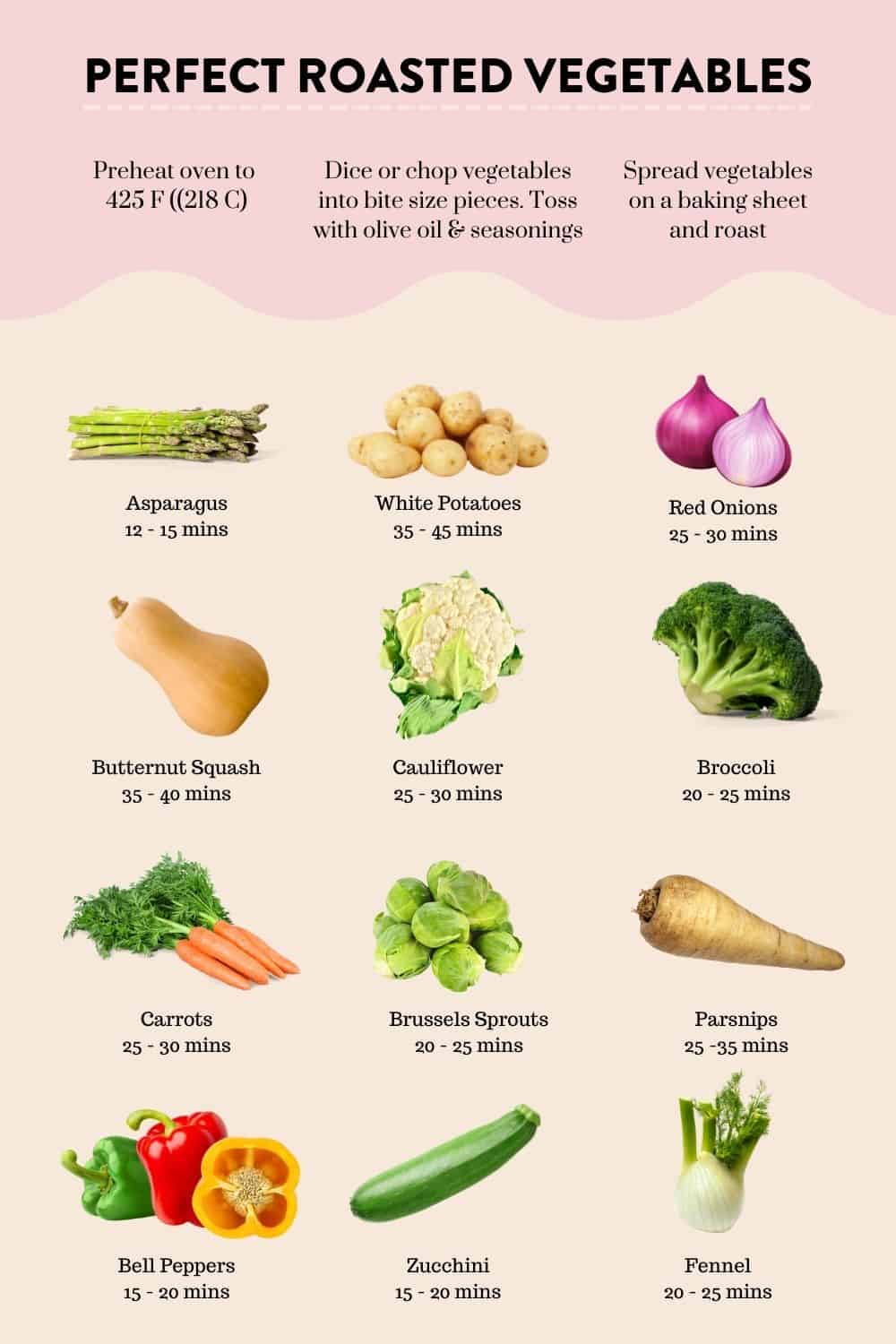To enjoy perfectly delicious vegetables, follow these vegetable roasting times and tips to get the most out of your produce.
We've included some roasted vegetable recipes for inspiration and answers to commonly asked questions about roasted vegetables.
What's your favorite vegetable to roast? Let us know in the comments below!

The Best Temperature for Roasting Vegetables
You need to use high heat to make the most succulent roasted vegetables. I recommend roasting vegetables at 400 degrees F (200 C) or 425 F (218 C).
You can roast vegetables anywhere from 350 to 450 F.
Higher temperatures will brown the vegetables, deepening their flavor and creating crispiness. Some vegetables won't hold up under 450 degrees F, so we recommend 400 to 425 F as the best temperature.
Roasting Times for Vegetables
These times are for roasting vegetables at 425 degrees F.
- Root vegetables (potatoes, turnips, beets, carrots, rutabaga) - 35 to 40 minutes
- Winter squash (delicata squash, butternut squash, acorn squash) - 40 to 50 minutes
- Crucifers (broccoli, cauliflower, radishes, Brussels sprouts) - 20 to 30 minutes
- Soft vegetables (zucchini, yellow squash, eggplant, bell peppers) - 10 to 20 minutes
- Thin vegetables (green beans, asparagus, snap peas) - 10 to 15 minutes
- Onions (white onions, red onions, shallots) - 25 to 30 minutes
- Tomatoes (cherry tomatoes, sliced tomatoes) - 15 to 20 minutes
Recipes for Roasting Vegetables
- Roasted Brussels Sprouts - Roasting Brussels sprouts brings out all their flavor! This great, easy side dish of roasted Brussels sprouts is always a hit.
- Easy Roasted Beets - This roasted beets recipe is a super easy and delicious side dish. It takes very little hands-on time.
- Crispy Roasted Sunchokes - Roasting sunchokes to crispy perfection is easy to do! Sunchokes have a lovely, delicate and sweet flavor for a root vegetable.
- Roasted Carnival Squash - You're going to love this roasted carnival squash recipe - it's so easy to make and results in creamy, succulent squash.
- Roasted Purple Potatoes - These roasted purple potatoes with garlic and herbs are a flavorful and beautiful side dish.
- Roasted Parmesan Green Beans - These delicious parmesan green beans are topped with panko and roasted to perfection.
- Roasted Artichoke Hearts - These delicious roasted artichoke hearts are topped with parmesan cheese and baked till crispy.
- Roasted Delicata Squash - Roasted delicata squash is a simple yet elegant side dish. It looks beautiful, tastes buttery and rich, and is so easy to make.
- Roasted Veggie Pasta with Feta - This creamy veggie pasta recipe is made with roasted vegetables, feta, baby arugula, and chunky pasta.
- Crispy Oven Roasted Potatoes - The crispiest roast potatoes with a few easy steps - all while roasting them with only olive oil!
- Roasted Rainbow Carrots - These gorgeous roasted rainbow carrots are a delicious and elegant side dish recipe.
- Roasted Turnips Recipe - These delicious roasted turnips are a simple, flavorful side dish that's easy to make.
Roasting Vegetable FAQs
Should you cover vegetables when roasting them?
Vegetables should not be covered while roasting. If you cover vegetables with aluminum foil, you'll steam them. Vegetables should be uncovered in the oven to get the char from roasting.
Is it okay to roast vegetables with olive oil?
Yes, you can roast vegetables with olive oil. Unlike other oil types (vegetable or canola oil), olive oil imparts more flavor to veggies. Olive oil can be used to roast vegetables up to 500 degrees F, while extra virgin olive oil should only be heated up to 400 degrees F.
Should you cut vegetables before roasting?
Some vegetables benefit from being cut into bite-size pieces before roasting. This allows more surface area to get roasted and caramelized while in the oven.
Sometimes, you may want to roast a vegetable whole—like a head of cauliflower, beets, or asparagus stems. But many vegetables, like winter squash, onions, zucchini, Brussels sprouts, and potatoes, should be cut before roasting.
Can roasted vegetables be reheated?
Yes, roasted vegetables can be reheated! Try reheating them in the oven or toaster oven for a crispier texture. Microwaving your vegetables to reheat them can make them soggy.





Leave a Reply